The rise of remote work has dramatically changed how businesses operate. With 77% of remote employees reporting greater productivity outside the office, flexible work models are here to stay.
However, embracing hybrid teams requires rethinking everything from software platforms to phone systems. Legacy on-premises phone solutions fall short for hybrid workforces.
Luckily, cloud-based remote working phone systems now enable teams to maintain seamless collaboration and customer support from any location.
In this guide, explore the benefits of modern VoIP phone systems for remote call management, auto-attendants, IVR menus, and omnichannel contact centers. Discover the top 7 virtual phone system providers and compare their features, pros, and cons for the perfect choice.
"Evaluate factors like scalability, integration capabilities, and essential features such as call forwarding and voicemail-to-email functionality. Additionally, consider the reliability of the internet connection, ensuring it can support seamless VoIP communication. Opt for a well-established remote phone system provider with a proven track record for excellent customer support and security measures. Consider piloting new solutions with a small focus group first and solicit ongoing feedback from remote staff on how the system can best facilitate their work from anywhere."
What is a Remote Phone System?

A remote phone system, also known as a hosted or cloud phone system, allows businesses to set up and manage their company phone services over the Internet rather than with on-premise hardware located at their office.
With the best phone system for remote workers, employees can use softphone applications on their computers or mobile devices to make and receive phone calls, voicemails, conference calls, and other telephony features from any location with an internet connection.
This provides flexibility for employees to work remotely while still being reachable by phone. Remote phone systems offer call management features like dial maps, queues, and auto attendants to route incoming phone calls efficiently.
They are scalable remote working phone systems that save businesses money compared to traditional on-site PBX systems while still providing enterprise-grade phone capabilities and continuity of operations regardless of where employees choose to take phone calls.
A remote phone system allows businesses to set up and manage their company phone services over the Internet rather than with on-premise hardware located at their office.
Cloud providers assume hardware, software, and maintenance costs, while organizations pay low monthly per-user rates.
Work-from-home phone system requires an intuitive web-based admin portal that allows easy configuration of call routing policies, auto-receptionist, contacts, extensions, IVR menus, and advanced call flows/settings.
Top 10 Remote Phone Systems
Selecting the right remote phone platform involves researching the leading vendors and comparing offerings. This list highlights seven of the best phone systems for remote workers on the market today. The top remote phone system choices for 2025 are below:
| Provider | Best For | Key Features | Pricing | Unique Differentiator |
|---|---|---|---|---|
| CallHippo | Remote teams, startups & global SMBs | Virtual numbers, global call routing, call analytics, team collaboration | Starts at $16/user/month | Quick setup with remote-ready dashboards and AI-powered productivity tracking |
| Aircall | CRM-driven sales and support teams | Click-to-dial, integrations, real-time analytics, IVR | Starts at $30/user/month | Strong CRM and helpdesk integrations with easy setup |
| Nextiva | Enterprises and large remote teams | VoIP, video conferencing, collaboration tools | Starts at $18.95/user/month | All-in-one communication with advanced productivity tools |
| Ooma | Small businesses with basic needs | Call forwarding, voicemail, mobile app | Starts at $19.95/user/month | User-friendly setup for micro teams |
| GoTo Connect | Hybrid and remote workforce | Video meetings, team messaging, call handling | Starts at $27/user/month | Built-in video and messaging with VoIP |
1. CallHippo
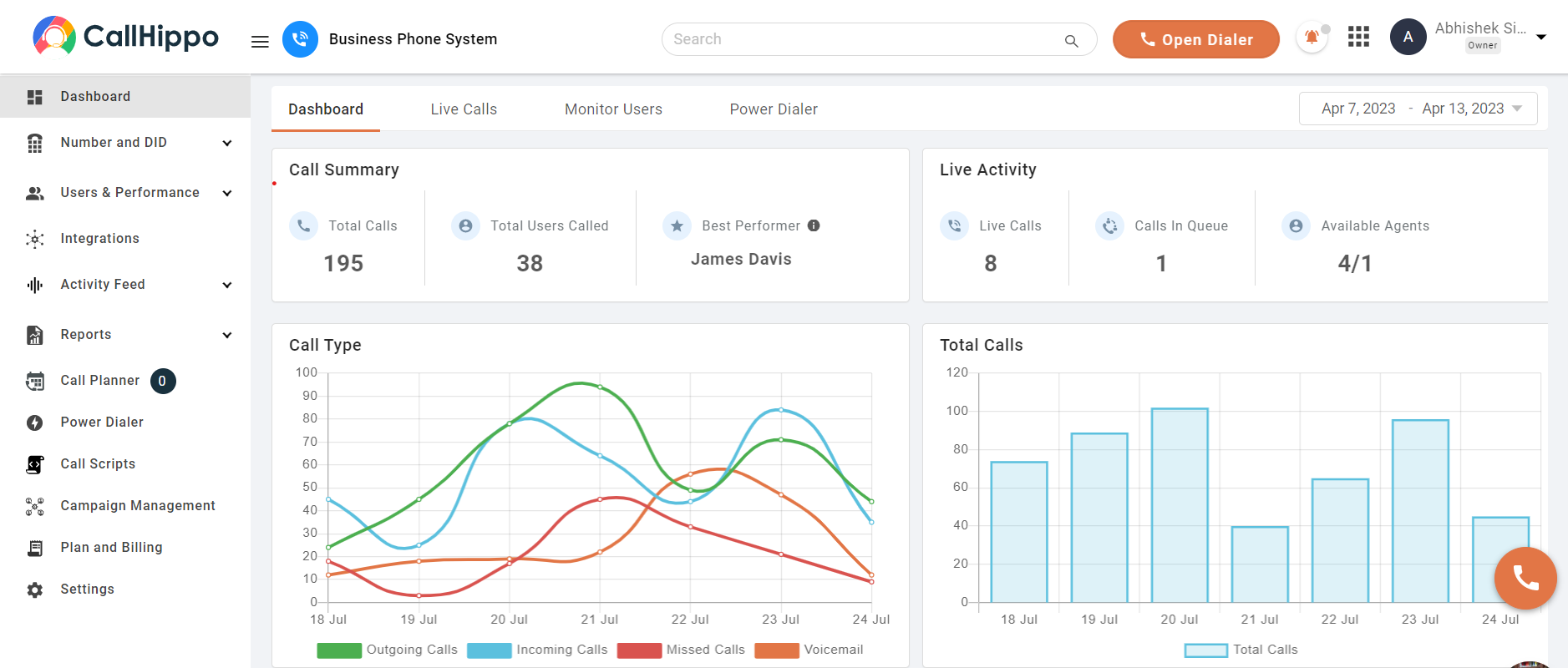 CallHippo is one of the best phone systems for remote workers, enabling WFH teams to collaborate effectively. Its reliable voice and video calling, contact center capabilities, CRM integrations, and call recording make CallHippo an ideal unified communications platform. Built-in security features plus customizable IVRs, on-hold music, and greetings optimize customer interactions. CallHippo seamlessly integrates popular business apps and provides the enterprise-grade remote phone system features growing businesses need with intuitive usability.
CallHippo is one of the best phone systems for remote workers, enabling WFH teams to collaborate effectively. Its reliable voice and video calling, contact center capabilities, CRM integrations, and call recording make CallHippo an ideal unified communications platform. Built-in security features plus customizable IVRs, on-hold music, and greetings optimize customer interactions. CallHippo seamlessly integrates popular business apps and provides the enterprise-grade remote phone system features growing businesses need with intuitive usability.
Features
- Free unlimited calling
- Auto-attendant (IVR) and Ring groups
- Call routing & forwarding
- Business app integrations
- Call analytics
- Call park & recording
- Local phone numbers & toll-free number
- Call distribution
Pros
- Small businesses and startups can benefit from CallHippo's free usage package.
- The configuration process is speedy and straightforward, ensuring efficient setup.
- Integration with CallHippo is a seamless and swift process, enhancing user convenience.
- CallHippo is easily accessible through both desktop and mobile applications, providing flexibility in usage.
Cons
- Users may experience occasional call lags, which can disrupt communication flow.
- Unfortunately, CallHippo does not offer free text messaging as part of its service.
- At times, there are instances where connections may break, causing potential frustration for users.
Pricing
- Bronze Plan: $16 per user per month
- Silver Plan: $24 per user per month
- Platinum Plan: $40 per user per month
- Enterprise Plan: $48 per user per month
2. Aircall
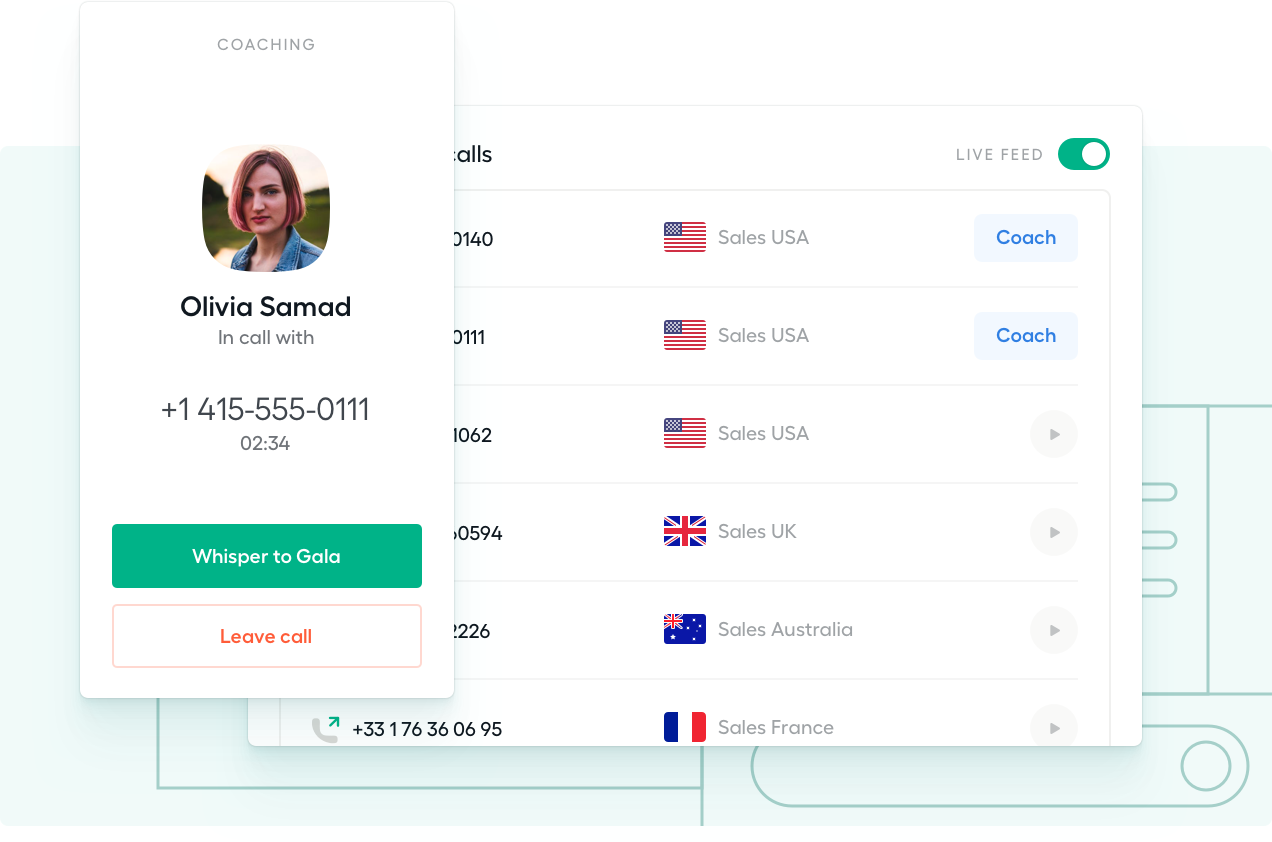 Aircall is a cloud phone system designed specifically for modern, distributed teams. Its browser-based interface centralizes calling, contact management, help desk, and other collaboration tools for remote productivity. This best phone system for remote workers streamlines handle high call volumes across global regions cost-effectively. Interactive voice menus and smart routing options deliver polished customer experiences. For rapidly scaling startups to midmarket companies, Aircall delivers full-featured and reliable cloud telephony.
Aircall is a cloud phone system designed specifically for modern, distributed teams. Its browser-based interface centralizes calling, contact management, help desk, and other collaboration tools for remote productivity. This best phone system for remote workers streamlines handle high call volumes across global regions cost-effectively. Interactive voice menus and smart routing options deliver polished customer experiences. For rapidly scaling startups to midmarket companies, Aircall delivers full-featured and reliable cloud telephony.
Features
- Unlimited inbound calls (toll-free excluded)
- Softphone for desktop, Android, iOS
- Mandatory call tagging
- Advanced analytics and call monitoring
- Custom onboarding
- Access to API developer support
- Service-level agreement (SLA)
- Unlimited simultaneous outbound calls
Pros
- The remote office phone system allows reaching clients in multiple countries effortlessly.
- The call clarity provided by this system is outstanding, enhancing communication quality.
- It seamlessly integrates with HubSpot, streamlining business operations effectively.
- Its exceptional smartphone app greatly enhances communication and accessibility.
Cons
- The system lacks effective SMS integration, limiting messaging capabilities.
- Users have reported poor customer service associated with this phone system.
- There have been noted issues with routing, affecting call connectivity and flow.
Pricing
- Essentials – $30 /license
- Professional – $50 /license
- Custom –
- AI STARTER ADD-ON – $9/license
3. Nextiva
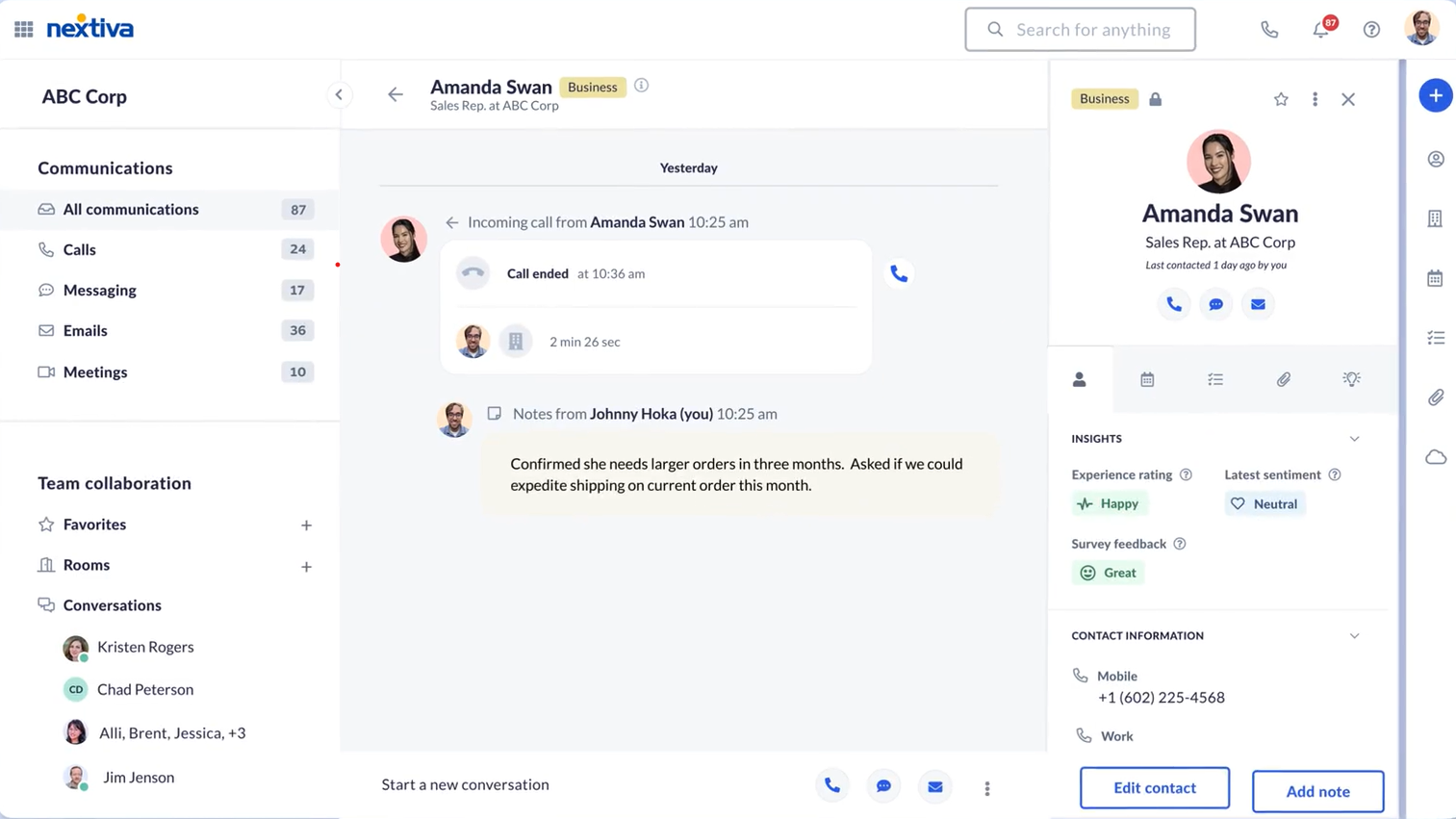 Nextiva provides an end-to-end cloud business communications platform merging phone service with omnichannel customer engagement tools and analytics. Its reliable VoIP calling and flexible IVR menus combine with unified messaging, live chat, help desk, CRM integrations, and AI analytics capabilities within a streamlined interface. Nextiva simplifies connecting dispersed teams and delivering exceptional customer experiences.
Nextiva provides an end-to-end cloud business communications platform merging phone service with omnichannel customer engagement tools and analytics. Its reliable VoIP calling and flexible IVR menus combine with unified messaging, live chat, help desk, CRM integrations, and AI analytics capabilities within a streamlined interface. Nextiva simplifies connecting dispersed teams and delivering exceptional customer experiences.
Features
- Automatic call distribution
- Auto-attendant
- Caller ID
- Call forwarding & queuing
- Visual voicemail
- Voicemail to email
- Voicemail forwarding
Pros
- The calls maintain a high level of quality, ensuring clear communication.
- Configuring the dashboard is simple and user-friendly.
- The billing process is consistently smooth and reliable.
- Voice messages are conveniently and automatically forwarded to email for easy access.
Cons
- Integration capabilities could be improved to enhance overall system functionality.
- The phone app's performance and features could be enhanced for a better user experience.
- Signal strength and call stability could be improved to enhance the system's reliability.
Pricing
- Essential Plan: $23.95 per user per month
- Professional Plan: $27.95 per user per month
- Enterprise Plan: $37.95 per user per month
You May Also Read : The Benefits of Work From Home Phone Solutions
4. Ooma
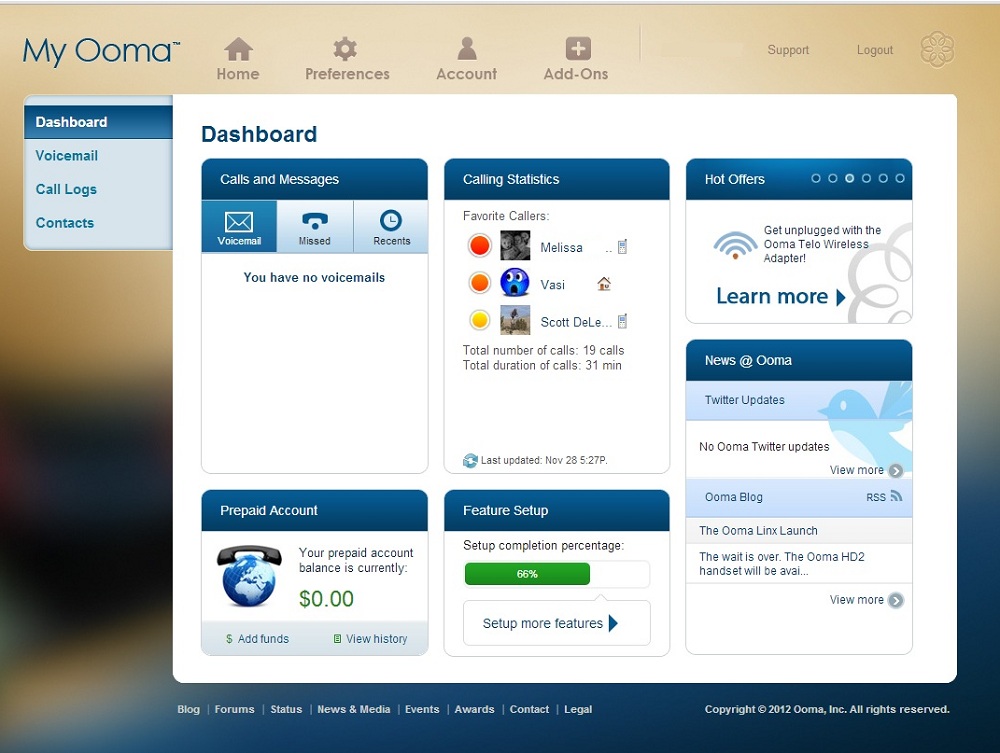 Ooma Office is a leading, feature-packed cloud phone service built for smaller businesses. Ooma offers enterprise-level capabilities like multi-location support, call routing, interactive voice menus, ring groups, hold music, conferencing, voicemail to email, CRM integrations, mobile apps, and more. Ooma’s reliable nationwide coverage and clear call quality optimize for SMBs without compromising needed features.
Ooma Office is a leading, feature-packed cloud phone service built for smaller businesses. Ooma offers enterprise-level capabilities like multi-location support, call routing, interactive voice menus, ring groups, hold music, conferencing, voicemail to email, CRM integrations, mobile apps, and more. Ooma’s reliable nationwide coverage and clear call quality optimize for SMBs without compromising needed features.
Features
- Virtual receptionist
- Call park
- Ring groups
- Music on hold
- Transfer music
- Extension dialing
- Extension monitoring
- Call forwarding
Pros
- The system conveniently forwards calls from my office phone to my cell phone, ensuring I stay connected on the go.
- It provides the functionality to listen to voicemails through my email, enhancing accessibility and convenience.
- This business phone system offers a plethora of great features, meeting a wide range of communication needs.
- It proves to be cost-effective, allowing for efficient communication without incurring substantial expenses.
Cons
- Navigating the setup process could be made simpler for a more user-friendly experience.
- The review of call logs can be cumbersome due to the system's interface.
- Unfortunately, the Ooma App lacks the feature of call waiting, which could improve the overall user experience.
Pricing
- Essentials Plan: $19.95 per user per month
- Pro Plan: $24.95 per user per month
- Pro Plus Plan: $29.95 per user per month
5. GoTo Connect
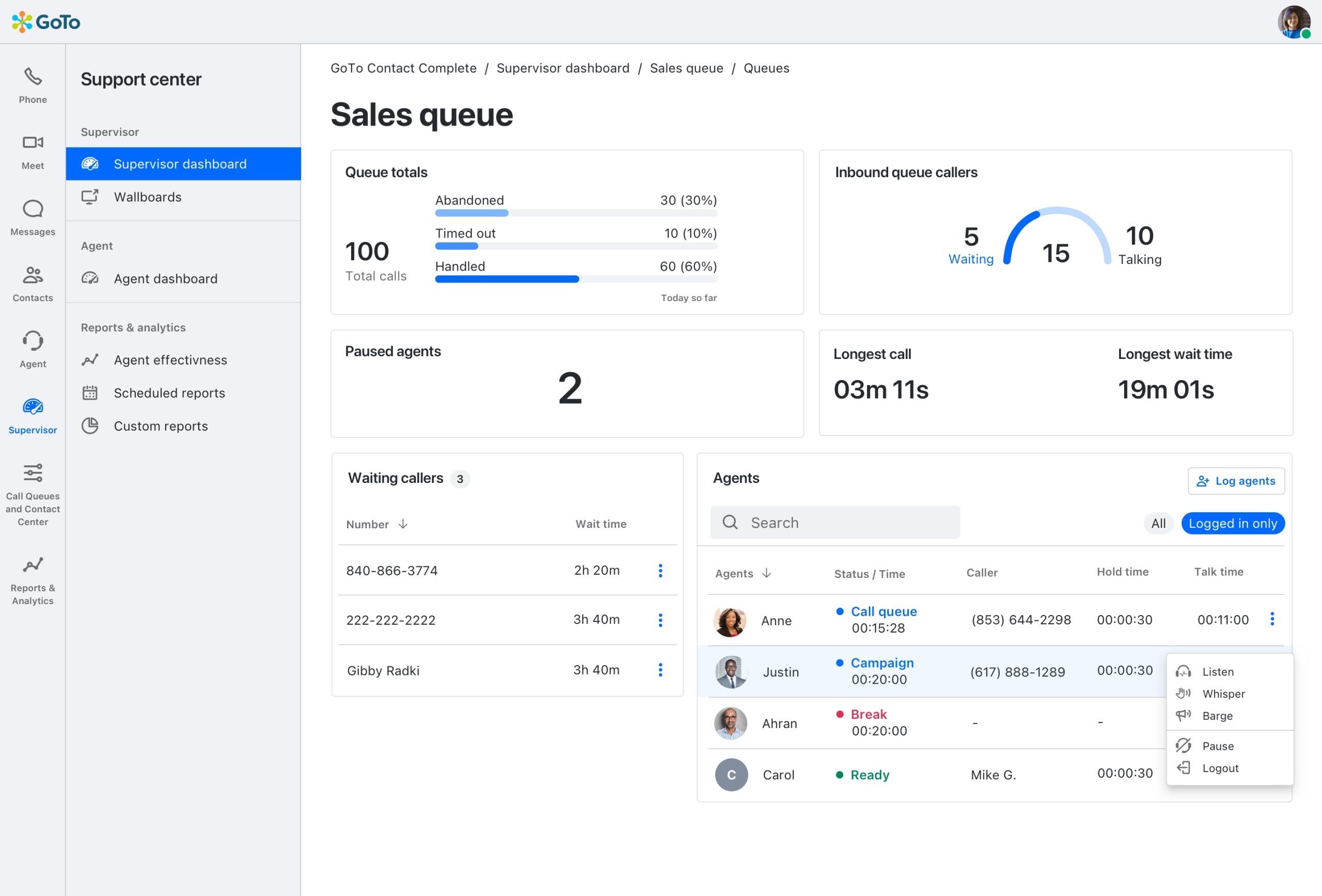 GoToConnect is a leading business phone system that allows users to manage business communications from anywhere. It offers feature-rich mobile and desktop softphone apps to enable seamless call handling on any internet-connected device. GoToConnect integrates tightly with popular productivity tools and provides analytics to optimize team efficiency. The scalable solution is affordable and easy to manage remotely.
GoToConnect is a leading business phone system that allows users to manage business communications from anywhere. It offers feature-rich mobile and desktop softphone apps to enable seamless call handling on any internet-connected device. GoToConnect integrates tightly with popular productivity tools and provides analytics to optimize team efficiency. The scalable solution is affordable and easy to manage remotely.
Features
- Existing number porting
- Local, toll-free & vanity numbers
- Smart call routing
- Unlimited extensions
- Call forwarding
- Instant response
- Auto attendant recorded greetings
- Customizable dial plans
- Ring groups
Pros
- High-definition video conferencing is accessible on all plans, ensuring top-quality video interactions.
- This working-from-home phone solution is designed with an intuitive and user-friendly interface, particularly beneficial for beginners navigating the platform.
- The Dial Plan Editor feature streamlines the management of call flows, making it easier and more efficient to handle.
- Remarkable sound quality enhances the overall communication experience, providing clear and crisp audio.
Cons
- The Basic plan imposes a limitation on video meetings, allowing only up to four participants at a time.
- The system lacks end-to-end encryption, potentially raising concerns about data security and privacy.
- Occasionally, updates to the system can present challenges, requiring some effort and patience to navigate through the process.
Pricing
- Basic – $27 per user per month
- Standard – $32 per user per month
6. CloudTalk
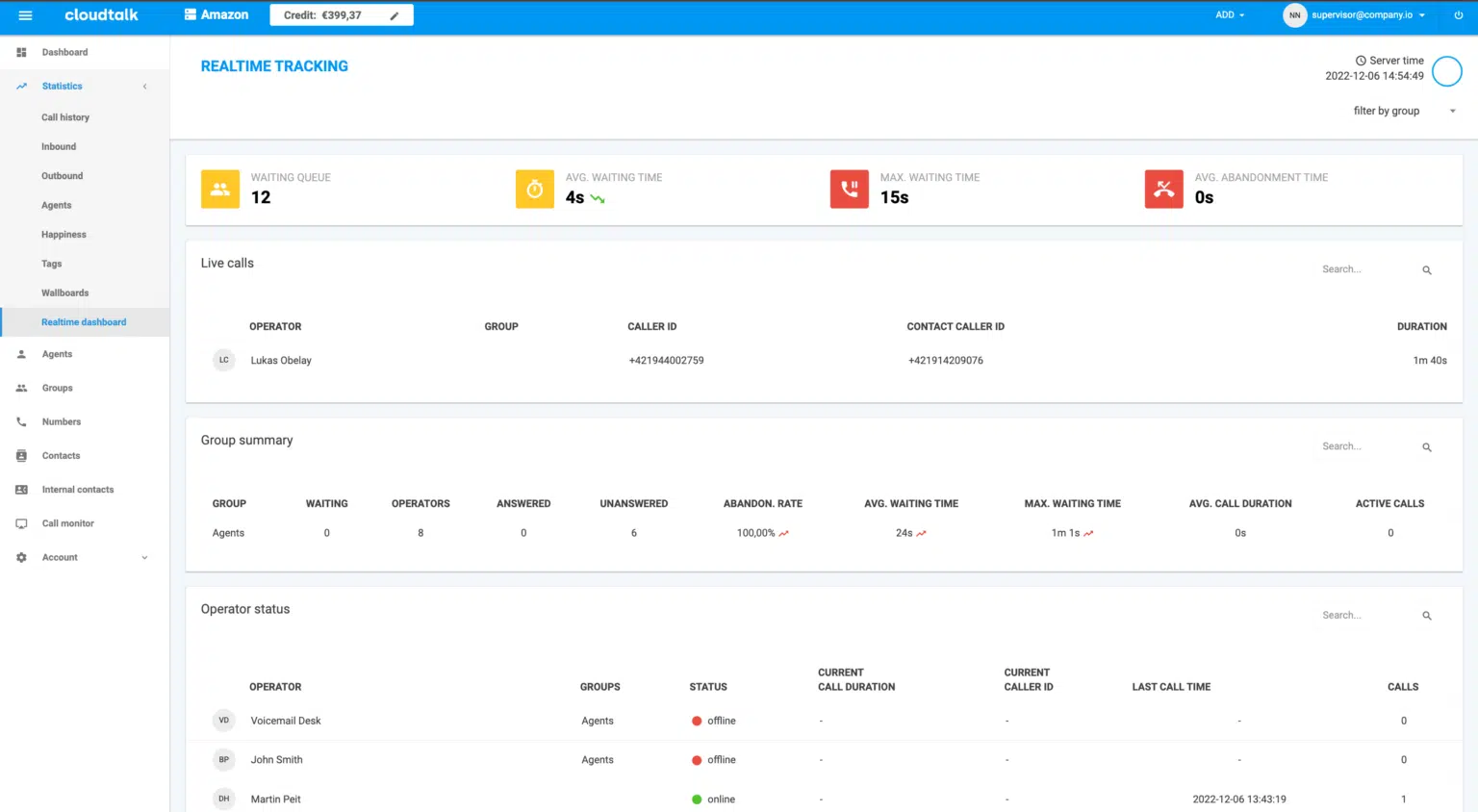 CloudTalk is a flexible VoIP phone service that gives remote workers full business telephony functionality. The customizable solution provides HD audio conferencing, local or toll-free numbers, and virtual receptionist features empowering seamless call routing. CloudTalk integrates with many CRM and helpdesk tools to offer a consolidated communication interface accessible from any location.
CloudTalk is a flexible VoIP phone service that gives remote workers full business telephony functionality. The customizable solution provides HD audio conferencing, local or toll-free numbers, and virtual receptionist features empowering seamless call routing. CloudTalk integrates with many CRM and helpdesk tools to offer a consolidated communication interface accessible from any location.
Features
- Advanced analytics with unlimited history
- Real-time client dashboard
- Integrations to other systems
- Open API
- Skill-based routing
- Smart queueing
- Workflow automation
Pros
- There's a variety of integration options available to choose from, enhancing flexibility and compatibility with existing systems.
- The system offers monitoring and statistics features, enabling comprehensive insights and analysis for improved decision-making.
- Exceptional customer support is provided, ensuring a reliable and helpful resource for addressing any concerns or issues.
- Efficiently connect and synchronize data with your current CRM, streamlining information management and accessibility.
Cons
- The availability of call summary notes is limited, potentially hindering comprehensive post-call documentation and follow-up.
- Additional administrative access beyond standard user and operator permissions is lacking, limiting customization and control capabilities.
- The Windows application of this working-from-home phone solution could benefit from enhancements to improve user experience and functionality.
Pricing
- Starter – $25 per user/month
- Essential – $30 per user/month
- Expert – $50 per user/month
- Custom – Custom pricing
7. JustCall
JustCall is an intuitive work-from-home phone system designed for growing distributed businesses. The platform offers reliable calling, conferencing, and business SMS capabilities through user-friendly mobile and desktop apps. JustCall integrates easily into existing workflows through common CRM and collaboration tool partnerships.
Features
- Sales Dialer – Predictive & dynamic dialers
- Bulk SMS & SMS workflows
- Live call monitoring (listen, whisper & barge)
- Intelligent routing
- Salesforce integration
- 100+ integrations – CRM systems & help desk tools
- IVR / Call menus
Pros
- Obtain and utilize local phone numbers from 58 countries for a global reach.
- Seamlessly integrate the system with a wide array of CRM and Helpdesk software.
- Benefit from a reliable call forwarding system, ensuring uninterrupted communication.
- Maintain accurate and clear call logs and recordings, enhancing communication tracking.
Cons
- This work-from-home phone system exhibits bugs that affect its performance.
- Experience subpar customer support when seeking assistance.
- Encounter significant lag during calls, impacting real-time communication.
Pricing
- Essential – $19 per user/month
- Team – $29 per user/month
- Pro – $49 per user/month
- Business – Custom pricing
8. RingCentral
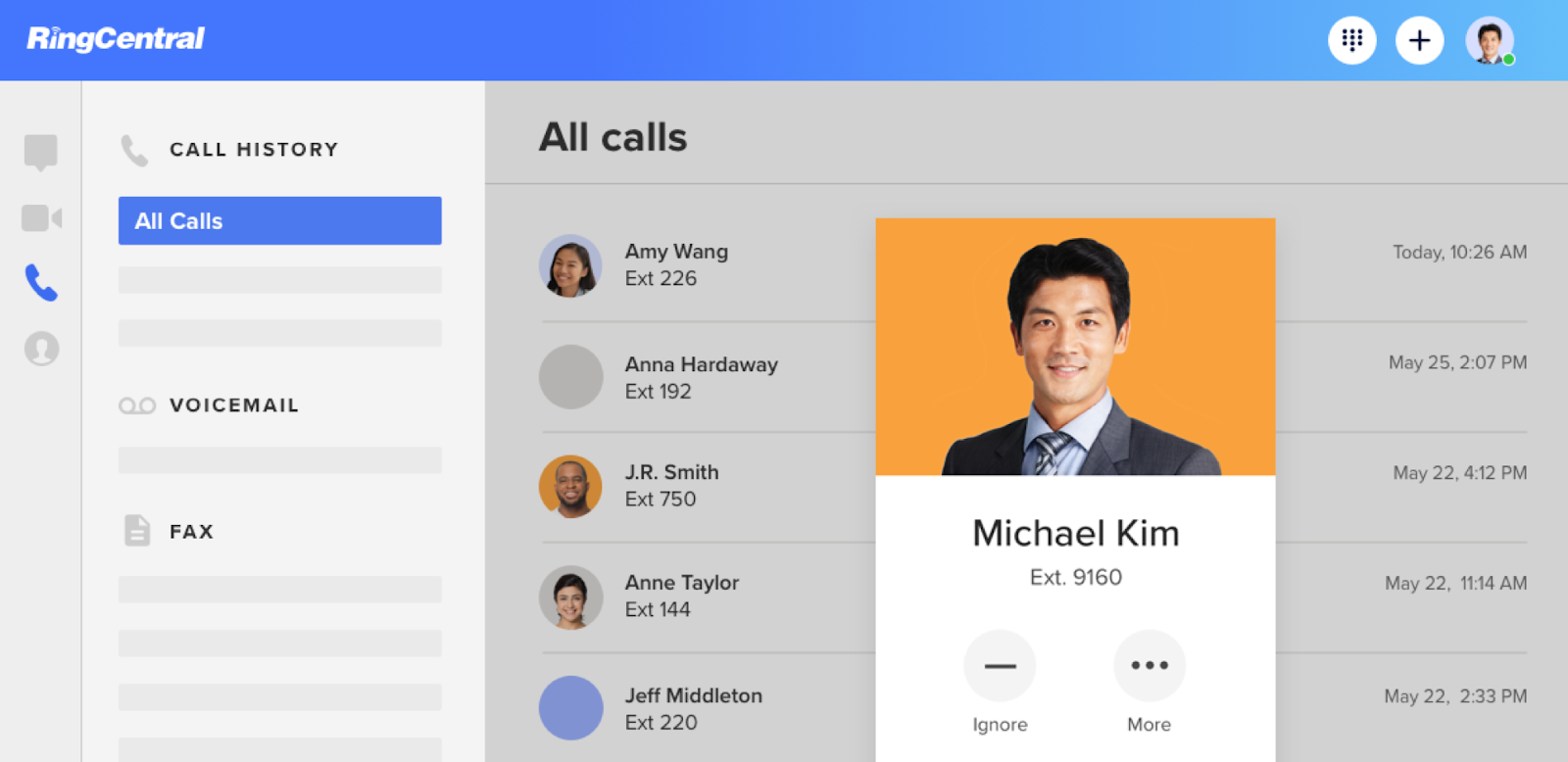 RingCentral offers a powerful yet user-friendly phone solution for remote businesses. With RingCentral, you can productively connect employees across any device and location. The platform is easy to use, with a simple setup and intuitive call and message routing. This allows remote teams to seamlessly collaborate, share files, and interact with customers. Moreover, it integrates seamlessly with numerous third-party applications, allowing you to create automated workflows.
RingCentral offers a powerful yet user-friendly phone solution for remote businesses. With RingCentral, you can productively connect employees across any device and location. The platform is easy to use, with a simple setup and intuitive call and message routing. This allows remote teams to seamlessly collaborate, share files, and interact with customers. Moreover, it integrates seamlessly with numerous third-party applications, allowing you to create automated workflows.
Features
- Unlimited calling in the US/Canada
- Visual voicemail
- Multi-level auto attendant
- AI noise cancellation
- Incoming caller ID
- Team messaging and file sharing
- AI meeting insights
- 24/7 support
Pros
- RingCentral provides a wide array of easy-to-use communication tools that facilitate collaboration for remote teams.
- It integrates with many popular business software solutions like Salesforce, Office 365, Canvas, and Google to streamline workflows.
- This remote office phone system offers top-level security features like multi-factor authentication to keep call and data networks safe.
- The system scales as your business grows with more advanced features.
Cons
- This work-from-home phone system exhibits bugs that affect its performance.
- RingCentral phone plans have higher monthly costs compared to some competitors targeting small business segments.
- Number porting from old phone carriers can take several weeks with RingCentral.
- Support response times have been reported as slow for larger technical issues that require escalation.
Pricing
- Core: $20/user/month
- Advanced: $25/user/month
- Ultra: $35/user/month
9. Openphone
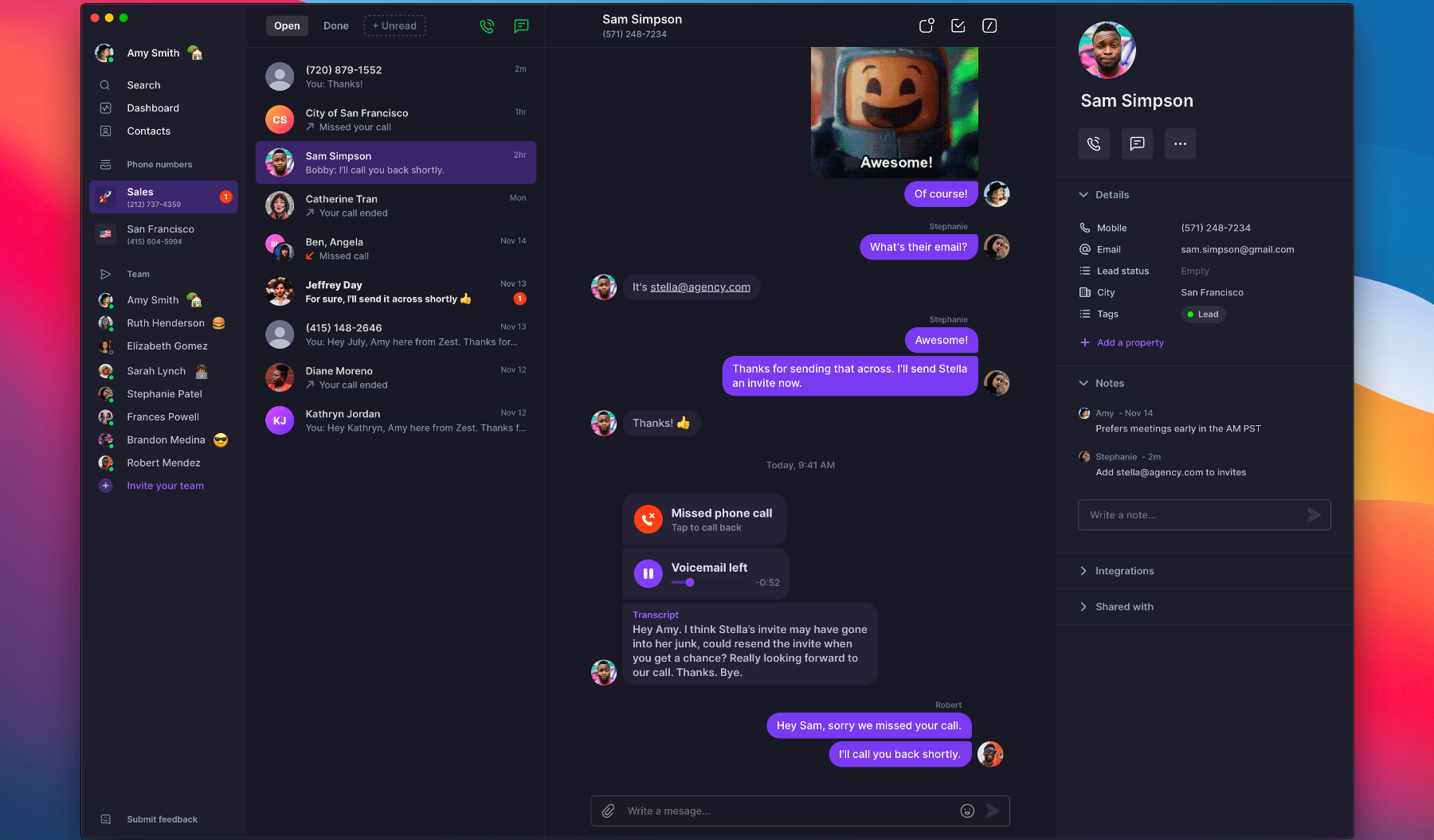 Openphone provides a versatile business phone system in the cloud. It makes staying connected remarkably easy for remote teams through its web and mobile apps. The system auto-routes calls seamlessly while enabling customizable business texting. Openphone stands out with its automated greetings, smart FAQs, and other tools to run your business smoothly from anywhere.
Openphone provides a versatile business phone system in the cloud. It makes staying connected remarkably easy for remote teams through its web and mobile apps. The system auto-routes calls seamlessly while enabling customizable business texting. Openphone stands out with its automated greetings, smart FAQs, and other tools to run your business smoothly from anywhere.
Features
- Unlimited calling in the US/Canada
- Shared phone numbers
- AI message responses
- Shared contacts
- Contact notes
- Business hours
- Voicemail transcripts
- Group messaging
Pros
- OpenPhone has an intuitive mobile interface that makes calls and messages simple for remote employees.
- Setup and configuration are quick and straightforward with OpenPhone, allowing rapid deployment.
- OpenPhone offers transparent, affordable pricing starting at just $10/month per user.
- Real-time communication features like chat, video meetings, and screen sharing foster collaboration.
Cons
- Call routing functionality is more limited compared to some competitors supporting larger enterprises.
- Integrations are currently more restricted beyond common tools like Slack or Zapier.
- International coverage and capabilities around toll-free numbers are not as extensive relative to leading platforms.
Pricing
- Starter: $15/user/month
- Business: $23/user/month
- Enterprise: Contact the company
10. Dialpad
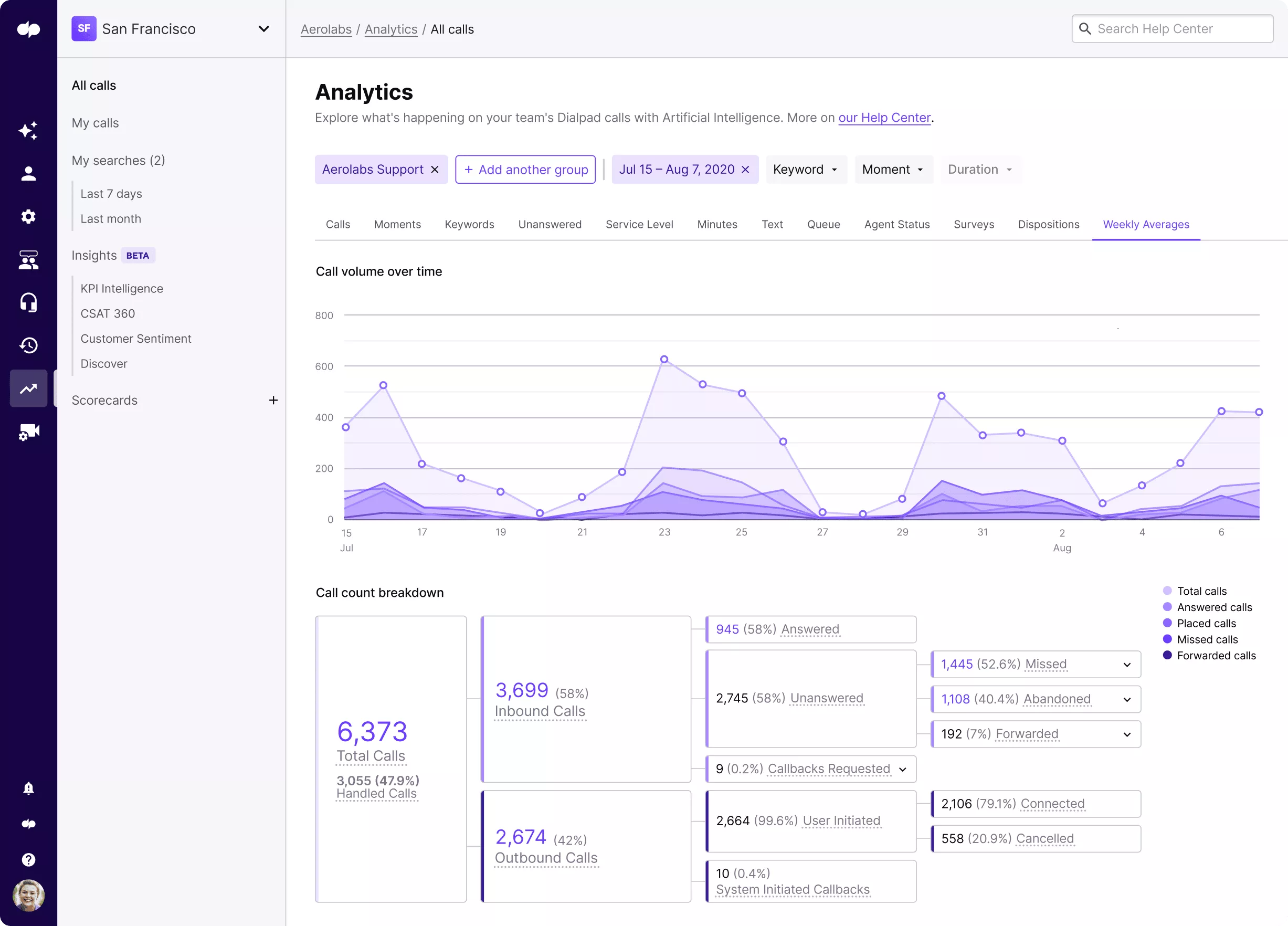 Dialpad takes a modern approach to enterprise business communications. Its Voice Intelligence layer uses AI to provide real-time transcription, note-taking tools, and call coaching to improve conversations. These smart features of its remote phone system boost productivity for individual employees and managers alike. With Dialpad, remote teams access a full-featured cloud phone system that’s simple to manage.
Dialpad takes a modern approach to enterprise business communications. Its Voice Intelligence layer uses AI to provide real-time transcription, note-taking tools, and call coaching to improve conversations. These smart features of its remote phone system boost productivity for individual employees and managers alike. With Dialpad, remote teams access a full-featured cloud phone system that’s simple to manage.
Features
- Unlimited AI meetings for up to 10 participants
- SMS, MMS & team messaging
- Ai-powered call & voicemail transcriptions
- Google Workspace & Microsoft 365 integrations
- Real-time analytics & reporting
- Web & chat support
- Open APIs & Webhooks
- Global SMS capabilities
Pros
- Dialpad utilizes AI features like real-time transcription and analytics for better calls.
- Dialpad supports native integrations with Google Workspace and Microsoft Office.
- It offers a full-featured video conferencing solution for meetings.
- You can seamlessly transition office numbers to Dialpad using local porting capabilities.
Cons
- The mobile experience lacks certain user-friendly features of some competitors.
- Customization of greetings and hold music is limited on Dialpad.
- Long 1-3-year minimum contracts are required for enterprise pricing tiers.
Pricing
- Standard: $15/user/month
- Pro: $25/user/month
- Enterprise: Contact the company
You May Also Read : All You Need To Know About Productivity Tools
Features To Look For In Remote Phone System
When shopping for a remote phone solution, it’s essential to understand what core functionality and add-ons are important for supporting your distributed workforce. The top features to look for in remote office phone systems options include: 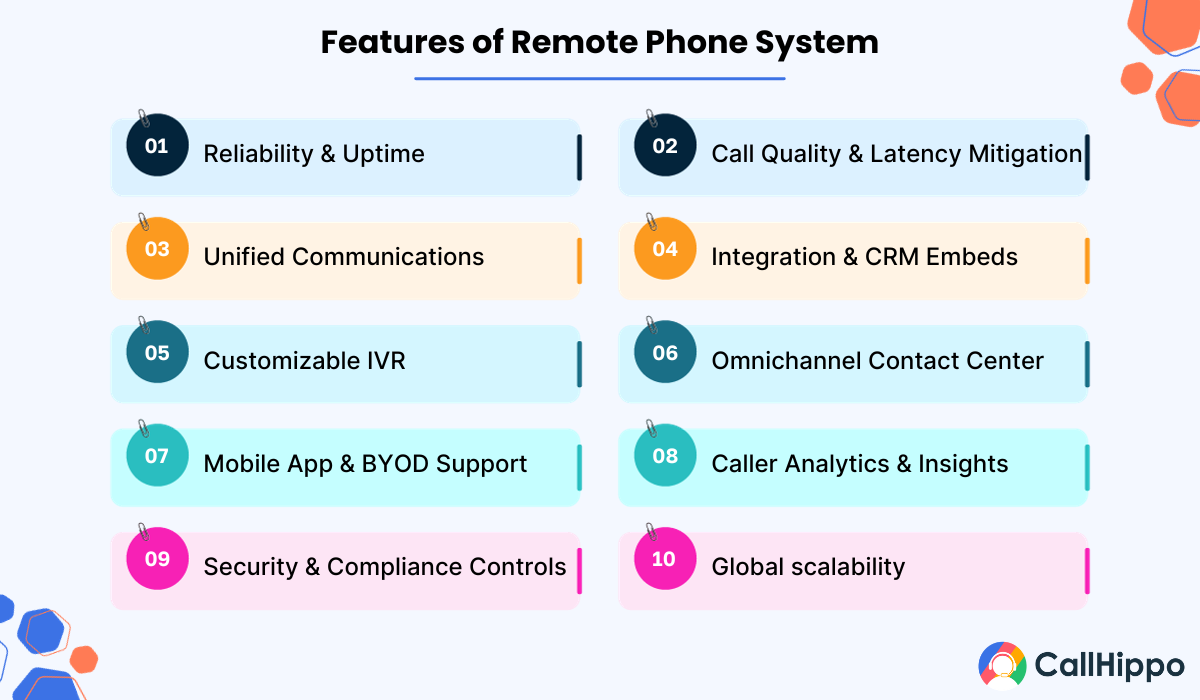
1. Reliability & Uptime
Look for remote phone systems that guarantee reliability with robust service level agreements (SLAs) stipulating guaranteed uptime/availability, maximum permissible outages, and concrete corrective processes. Prioritize a VoIP service provider that provides built-in failover and redundancy across globally distributed data centers. On-premises solutions should ensure easy failover capabilities as well. Telephone system outages can completely turn off business operations, so high reliability is a must.
2. Call Quality & Latency Mitigation
Ensuring excellent call quality with minimal latency is imperative for productive remote communications and happy customers. Seek remote office phone systems that route calls dynamically along optimal pathways using automated network analysis to circumvent congestion. Features like packet loss correction, echo cancellation, and noise reduction enhance quality. Confirm vendors optimize voice traffic on their networks and provide QoS controls.
3. Unified Communications & Collaboration Tools
Leading options integrate not just telephony features but also unified communications (UC) tools for team messaging, video conferencing, screen sharing, file collaboration, virtual rooms, and more. Unified interfaces boost productivity by consolidating communication channels. UC capabilities like browser-based video meetings, team chat apps, SMS messaging, and presence indicators streamline collaboration.
4. Integration & CRM Embeds
Phone systems should be embedded directly into essential productivity platforms like CRM/ERP solutions. Prioritize options providing third-party integrations or APIs for custom connections. Salesforce, Zoho, HubSpot, and other popular CRM integrations make call data readily accessible. Screen pops, click-to-dial, call logging, and related features boost productivity when integrated deeply into daily workflows.
5. Customizable Interactive Voice Response (IVR)
An intuitive Interactive Voice Response (IVR) system enhances customer experience by providing menu options for self-service around the clock. Prioritize IVRs that allow self-configuring menus, input times, and keypress options via simple visual editors without coding. Test out contextual options that change menus based on factors like calling numbers. Confirm the IVR integrates tightly with your CRM and backend.
6. Omnichannel Contact Center Functionality
Omnichannel contact centers unify diverse customer communication channels like voice, email, live chat, SMS messaging, and social media for consistent experiences. If managing customer support operations, seek phone systems providing unified omnichannel contact centers with skills-based routing, CRM integrations, reporting, and agent tools. Multichannel customer engagement should align with your business needs.
7. Mobile App & BYOD Support
For maximum flexibility, look for phone systems offering dedicated mobile device apps on iOS and Android to extend connectivity and collaboration to employees on the move. If supporting BYOD environments, ensure the solution provides self-service onboarding for end users to activate cell phone app features easily from personal devices. Enables work extension while maintaining policy control.
8. Caller Analytics & Insights
Leading options incorporate caller analytics like linked attribution reports, sentiment analysis, talk time trends, and speech-to-text transcription to see call insights. Business intelligence revealing optimal contact strategies, pain points, objection handling, and more helps improve future interactions. Useful for training purposes, too. Just ensure analytics access aligns with compliance standards.
9. Security & Compliance Controls
Verify remote phone solutions provide robust security and compliance capabilities tailored to your industry requirements. Encryption of business calls, voicemails, and files; user access controls and MFA; SOC2 compliance and data centers with SSAE 18, HIPAA, or PCI DSS certifications; recording consent options; data retention policies and more help satisfy regulatory standards and lower risks.
10. Global scalability
For multi site operations, opt for cloud platforms providing geo-distributed infrastructure that routes calls locally while enabling centralized management. Global solutions easily scale to meet demand surges at new international locations. Local number support also eases global business communications.
What are the Benefits of a Remote Office Phone System?
Remote office phone systems provide cloud-based telephone capabilities for distributed work environments. By hosting features through the Internet rather than physical desk phones, these solutions empower employees to efficiently handle calls from anywhere. 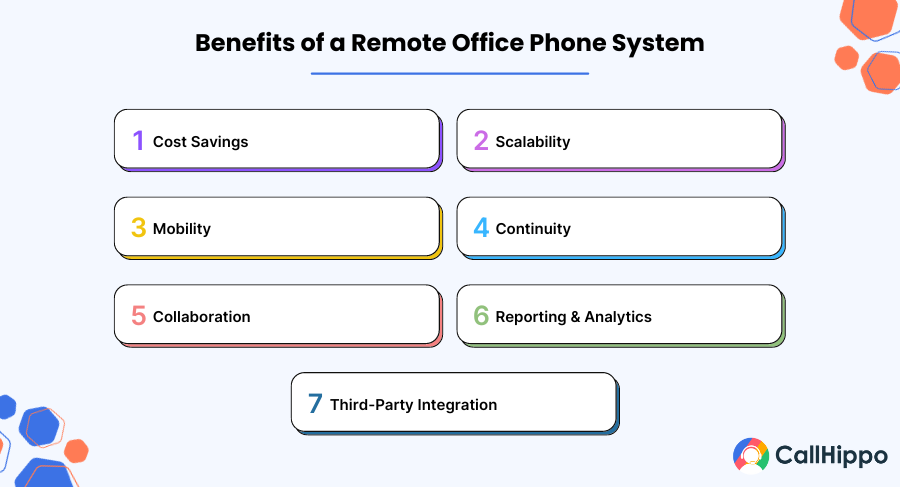
1. Cost Savings
Foremost, remote working phone systems streamline telecom expenditures versus on-premise solutions. Cloud providers assume hardware, software, and maintenance costs, while organizations pay low monthly per-user rates. Upfront phone system investments vanish while predictability replaces sporadic upgrade budgets. Further savings arise through consolidated billing and features priced atomically versus cumbersome bundles.
2. Scalability
Remote office phone systems to demand fluctuations seamlessly. Adding extensions involves provisioning software licenses versus complex infrastructure overhauls. New offices gain immediate telephony without costly last-mile configurations. Reorganizing teams becomes painless since call routing Follows personnel dynamically.
3. Mobility
Employees leverage any web-connected device as a full-fledged office phone with remote platforms. Softphone applications on smartphones, tablets, and laptops untether staff anywhere when paired with secure remote network access that enables reliable connectivity outside the corporate. Calls, voicemails, and extensions perform as dependably remotely as from desks. Telephony supplements rather than disrupt mobile workflows for maximized productivity.
4. Continuity
Remote infrastructures immunize operations against local disruptions through geo-redundant server replication. If calamities turn off primary support centers, traffic seamlessly reroutes to standby infrastructure. Calls, voicemails, and queues continue unabated. Centralized administrative portals make changing routing rules during crises effortless from afar.
5. Collaboration
Presence indicators and integration with team chat and video meeting solutions strengthen internal relationships remotely. Agents view each other’s availability before transferring inquiries. Supervisors gain conversational context through record and text transcription access. Inter-departmental communications meld voice, chat, and collaboration through unified directory access across disparate platforms. Caller identification and customized greetings personalize every interaction professionally for positive first impressions and foster loyalty.
6. Reporting & Analytics
Actionable call detail reports and wallboards present administrators with granular performance visibility. Automatic recording searches retrieve interactions instantly. Real-time monitoring spots bottlenecks early while post-call surveys capture sentiment. CRM integrations furnish 360-degree customer profiles to reps for contextual, consistent assistance.
7. Third-Party Integration
A seamless ecosystem connects presence, telephony, storage, collaboration, and third-party apps natively. Pre-integrated unifications bridge communications silos between platforms. Scripting capabilities layer telephone workflows onto existing processes elegantly. IVR routing streams callers through interactive customer journeys and personalizing experiences. Outbound notifications leverage number capacities for mass campaign delivery, maximizing reach.
How to Choose the Right Remote Phone System for Your Business?
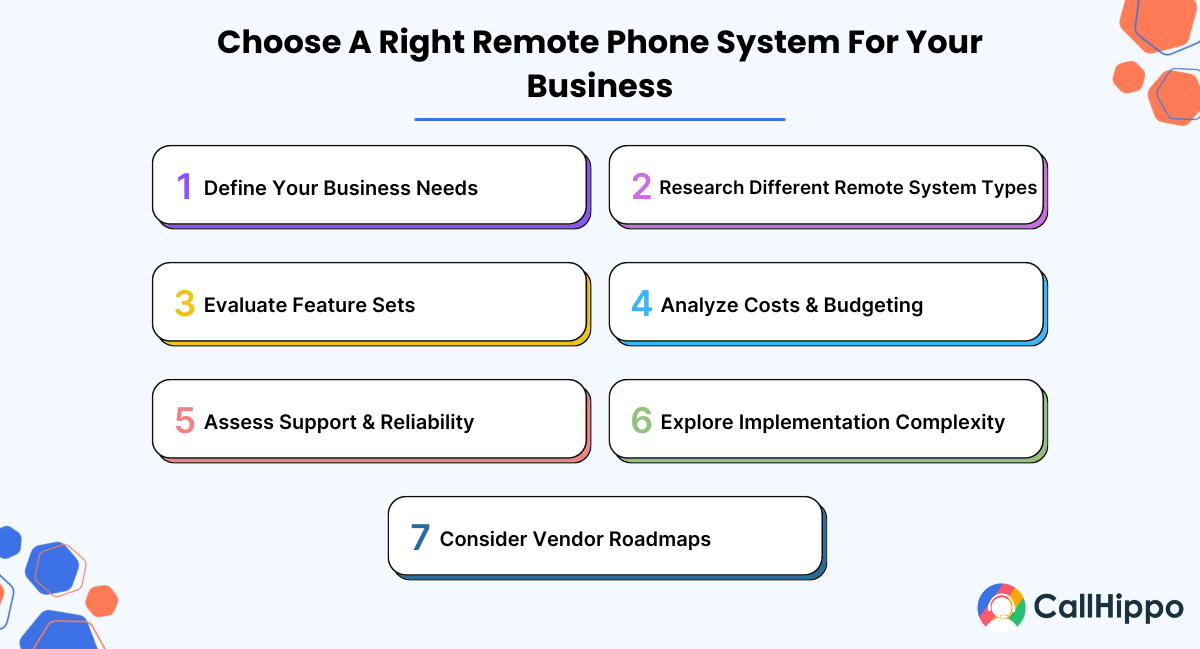 Choosing a work-from-home phone system requires evaluating your organization’s specific communication needs and budget. Consider key areas like the number of users, required features, integrations, and reliability when selecting providers. The important considerations for finding the best remote phone system for your business are below:
Choosing a work-from-home phone system requires evaluating your organization’s specific communication needs and budget. Consider key areas like the number of users, required features, integrations, and reliability when selecting providers. The important considerations for finding the best remote phone system for your business are below:
1. Define Your Business Needs
Start by assessing your communication requirements – how many users, locations, desired call features, etc. Consider growth potential when sizing needs. Factor in customer service expectations like support hours. Determine infrastructure – cloud-based vs. on-premise equipment impacts flexibility and setup differently for varying needs.
2. Research Different Remote System Types
Virtual phone systems let employees work remotely with softphone apps, accessing phone features virtually. Premise-based systems require hardware at each site. Hybrid models mix cloud PBX functionality with IP desk phones. Understand the pros/cons of ownership vs monthly subscription costs of each work-from-home phone system. Consider integrations important for your workflows like CRM or helpdesk software.
3. Evaluate Feature Sets
Review call management functionality like call forwarding, queues, IVR, call recording, etc. Ensure capabilities like mobility support across devices, conferencing, and menus suit needs. Weigh value adds such as reporting, auto-attendance, and integrated collaboration tools. For compliance, verify encryption requirements.
4. Analyze Costs & Budgeting
Factor equipment, licensing, activation, and additional user/feature fees alongside support contracts into the total cost of ownership profiles. Weigh predictable subscription costs against fluctuating overages from usage-based plans suitable for smaller businesses. Determine scalability for predictable user/location growth periods to avoid excessive additional charges.
5. Assess Support & Reliability
Workforce dynamics necessitate strong technical assistance. Assess uptime guarantees alongside support response performance indicators from vendor scorecards. Consider 24/7 assistance essential for emergencies. Read reviews detailing past outages or response delays that impact real business operations.
6. Explore Implementation Complexity
Simpler deployment saves time integrating into live workflows. Cloud-based plug-and-play flexibility comes at higher costs than premise hardware setups requiring infrastructure. Weigh training needs for administration against solutions with intuitive control panels. Approvals may be needed for capital expenditures on-premise equipment but provide ownership.
7. Consider Vendor Roadmaps
Investigate innovation timelines for integrations like WFH capabilities critical for future-proofing investments. Favor well-funded specialist firms continuously enhancing offerings matching evolving technology and industry trends. Compare long-term reliability by assessing customer satisfaction rating trends over the years with different vendors.
Wrapping Up
Remote and hybrid work are becoming standard, necessitating working-from-home phone solutions that transcend physical locations. Legacy PBX systems fall short of flexible operations. Cloud phone systems seamlessly connect distributed teams with capabilities like auto-attendants, IVRs, ring groups, and omnichannel routing. When selecting a platform, focus on ease of use, reliability, and features that will optimize workflows. Prioritize a Voice-Over Internet Protocol (VoIP system) like CallHippo that unifies voice with digital channels like chat and SMS for omnichannel management. With the right telephony foundation, remote employees maintain collaboration, culture, and productivity. As you equip teams with phone systems for remote offices, don’t overlook the human elements of change management and adoption support. Train employees on enhanced capabilities and new best practices to get the most from your investment. Maintain exceptional customer experiences and employee collaboration, no matter where work happens.
FAQs:
1. How To Set Up A Remote Office Phone System?
Setting up a remote office phone system involves:
- Selecting a provider.
- Choosing a plan.
- Setting up hardware or software.
- Configuring call routing.
- Integrating with existing tools.
2. How Much Does A Remote Phone System Cost?
The cost of phone systems for remote offices varies based on the provider, features, number of users, and plan chosen. For example, the bronze plan starts at around $16 per user per month. Many provider’s systems may range from $30 to $60 per user per month or more.
3. What is The Best Remote Office Phone System?
Determining the best remote office phone system depends on specific business needs and preferences. Popular options include CallHippo, Aircall, Nextiva, etc., each offering unique features and pricing structures.
4. How Does The Phone System Work?
A remote office phone system operates by utilizing internet-based VoIP (Voice over Internet Protocol) technology to transmit audio data over the Internet. Calls are made and received using devices connected to the Internet, such as computers, smartphones, IP desk phones, or softphones. The system routes calls, manages voicemail, enables conferencing, and integrates with business applications to enhance communication and collaboration.

Subscribe to our newsletter & never miss our latest news and promotions.








